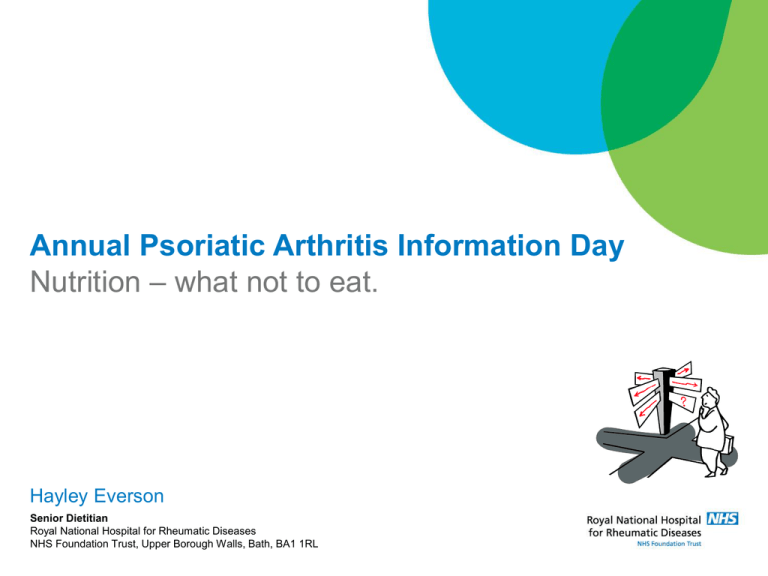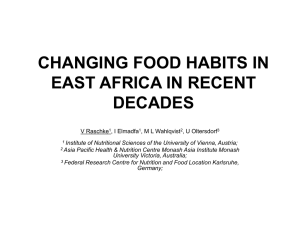What not to eat - Bath Institute for Rheumatic Diseases
advertisement

Annual Psoriatic Arthritis Information Day Nutrition – what not to eat. Hayley Everson Senior Dietitian Royal National Hospital for Rheumatic Diseases NHS Foundation Trust, Upper Borough Walls, Bath, BA1 1RL Aim and objectives Aim for the group to have an understanding of how a balanced healthy diet and maintaining a healthy weight can benefit the effects of arthritis. By the end of the session the group will • List the 5 food groups on the eat well plate • Compare food labels • Give examples of appropriate serving sizes www.rnhrd.nhs.uk Introduction • Common symptoms experienced include poor appetite, increased appetite, weight gain/loss, IBS symptoms, lack of energy/sleep, nausea, pain. Depression. • This is highly individual and varies from person to person, but can lead into adapting your diet. • If your diet is not balanced your general health will suffer making your arthritis worse. • If you are keen to try changing your diet please seek advise from a specialist so as to not cause any nutrient deficiencies. The Mediterranean Diet In order to help your arthritis it is important to • Eat a regular balanced diet and maintain a healthy BMI • Eat more fruits and vegetables • Substitute saturated fats for mono-unsaturates (MUFAs) • Eat plenty of fish • Cut down on sugar and salt • Drink alcohol in moderation Weight • Carrying excess weight is a common problem. Certain drugs can cause weight gain. • Even a small weight loss can reduce the strain on your joints • A healthy body weight is achieved by balancing the energy in our diet and the energy we use in activity. • A healthy BMI is between 20-25kg/m2. • BMI is weight Height 2 BMI Serving up meals – weight maintenance and loss Carbs Carbs Salad/veg Salad/veg Salad/veg Protein Protein Handy measures are: • Carbs = approx 30g, 1 slice bread, 4 tbsps cereal, 1-2 tbsps rice/pasta (2-3 servings allowed per meal) • Protein = approx 100g, deck of cards or a cheque book size (2 per day) • Fruit and Veg = approx 80g or a handful. (up to 5 per day) • Dairy = 30g matchbox of cheese, 200ml milk or small pot yoghurt. (2-3 per day) Carbohydrates • Have a regular eating pattern – 3 main meals per day • Include low GI (glycaemic index) carbohydrates with each meal. • Provides regular energy as glucose to help stabilise mood and reduce fatigue. • Breakfast kick starts metabolism, brain and body's normal functioning • Skipping meals leads to weight gain, low mood and fatigue. Also poorly controlled diabetes. Fruit and Veg • Aim for 5 fruits and vegetables portions (80g) per day. • These can be dried, juiced, frozen, tinned or fresh. Benefits; • Reduces pain and inflammation. • Low in fat and high in fibre • Contain anti-oxidants which help protect against disease causing chemicals • Can help regulate blood pressure and blood fats • Vitamin supplements do not provide the same benefits Dairy • Aim for 2-3 portions of dairy foods per day • These include yoghurts, cheese and milk • Low fat if possible • Skimmed milk contains more calcium than full fat. Ensure all types of milk are fortified with calcium. • Helps keep bones and teeth healthy and strong, reducing the risk of osteoporosis. • Ensure you get plenty of sunlight for vitamin D which helps absorb calcium • Other sources of calcium include fish, dark green leafy veg, pulses, cereals and some nuts and seeds. Fats – all have the same kcal content! • MUFAs – Have nuts, avocado, olives, and rapeseed oils to lower cholesterol. • Avoid trans/saturated fats from items such as lard, dripping, cakes, biscuits, chocolate, crisps, pies and pastries and all animal products. They can inhibit absorption of N3 fats and cause high cholesterol. • Take omega 3 oils in the form of fish oil to reduce inflammation. Sources include pilchards, salmon, sardines, mackerel and non tinned tuna. Non fish sources are flaxseed, walnuts, sweet potatoes, soya. Calcium and Vitamin D • Reduces risk of developing OA • The richest source of calcium is milk and dairy • Non dairy sources include soya/rice milk with added calcium, fish, beans, bread, fortified cereals some nuts, fruit and dark green veg. • Vitamin D is required to absorb calcium. The main source is sunlight between April and Sept. • Other sources of Vit D include oily fish, cereals, eggs and margarines Alcohol Consume in moderation as can lead to weight gain, high cholesterol, inflammation and IBS symptoms. Sensible limits: Men: 3-4 units/day Women: 2-3 units/day 2 alcohol free days/week Calculate the units using the equation.. Amount of alcohol in ml x strength i.e. percentage (ABV) 1000 Myth busting • Iron – relieves anaemia associated with arthritis, found in red meat, fish, cereals, beans and pulses, dried fruit, nuts and dark green veg. • Vitamin C – Reduces risk of developing OA and enhances absorption of iron • Tea/coffee – Inhibits absorption of iron and can contain caffeine which affects mood and energy levels • Probiotics – can reduce symptoms of diarrhoea, take daily for 1 month. Always keep bacteria strain consistent. • MSM, cider vinegar, honey and CMO – no evidence • Mild selenium deficiency may be associated with a progression of arthritis, but this can be toxic if too much is taken. Sources include meat, fish and brazil nuts. • All fruits and vegetables contain different antioxidants which have health benefits, it is therefore not advised to cut out various ‘families’. Symptom management - IBS • First line approach – Healthy eating, reducing sweeteners, fatty and spicy foods, caffeine, alcohol and fizzy drinks. Relaxation and stress management. • Fluid – Increase to 8-10 cups per day minimum • Fibre – If constipated increase, if diarrhoea reduce this • Intolerances – Rare, ask GP for tests for these if symptoms remain and you are losing weight • FODMAPS – New evidence based approach to IBS, excludes various types of carbohydrates (with support from Dietitian only.) Food and Mood Carbohydrates TRYPTOPHAN – an amino acid found in protein foods: SEROTONIN – a neurotransmitter responsible for good mood, sleep & appetite control CO-FACTORS Vitamin B6: yeast/ meat/ fish/ cereals/ fruit & vegetables Vitamin C: fruit & vegetables Zinc: seafood/ fruit/ nuts/ poultry/ meat/ cereals Folic Acid: beans/ citrus fruits/ grains/ green vegetables/ meat/ shellfish Food labelling – per 100g A lot A Little 20g fat or more 3g fat or less 5g saturated fat or more 1g saturated fat or less 10g sugars or more 2g sugars or less Rich tea vs digestive ‘light’ Further help • Keeping a food diary may help you make associations between symptoms and food or feelings • Ask your GP for a referral to a community Dietitian • See www.BDA.uk.com website for local freelance Dietitians and health factsheets • NHS choices website www.nhs.uk • Within Wiltshire there are free courses which help with mood and wellbeing – contact LIFT psychology Thank you for listening Any questions? www.rnhrd.nhs.uk








